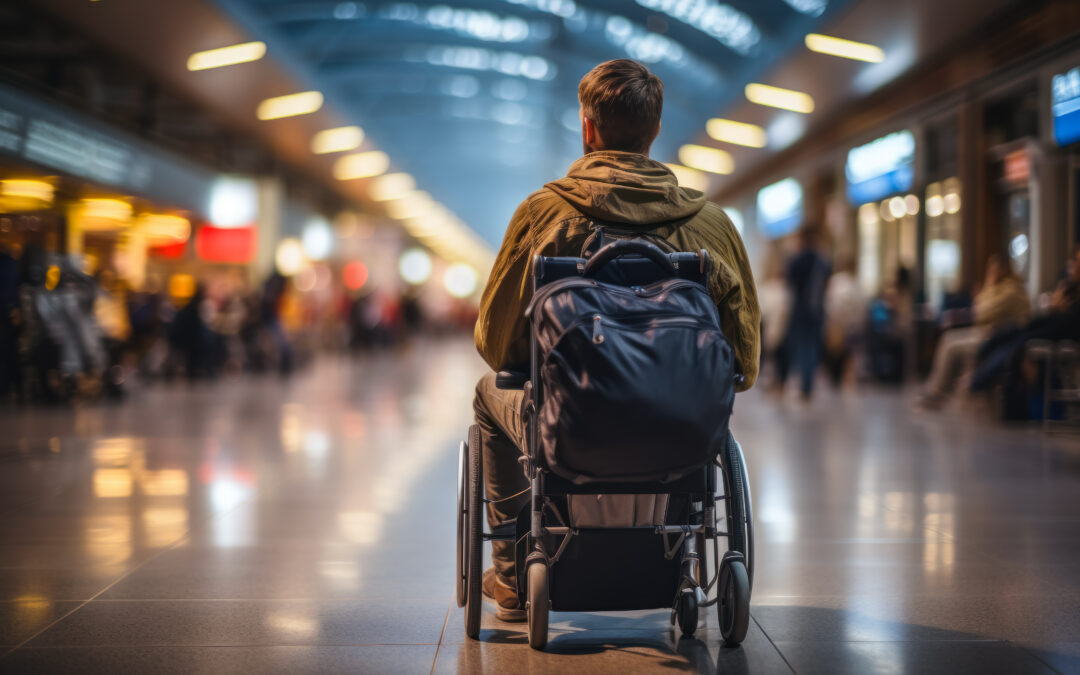Photo by ededchechine via Freepik.
Flying can be stressful for anyone, but for disabled travelers, it comes with an extra layer of challenges. Whether you’re traveling in Canada, the U.S., or abroad, knowing your rights can turn what might seem like a daunting experience into a smooth journey. Here’s some things that can be helpful for you to know, explained in plain language.
Your rights while flying in:
In Canada, you’re protected by the Accessible Transportation for Persons with Disabilities Regulations (ATPDR), which ensures airlines make travel seamless for people with disabilities. Here’s just a glimpse of what that can mean for a disabled traveler:
- Mobility Devices: Your wheelchair or mobility device must be transported free of charge. Airlines must handle these with care (and yes, you can hold them accountable for damages!).
- Service Requirements: On airplanes, passengers with disabilities must have access to the washroom with the most space, even if it’s in a different section of the aircraft. (P.S. Train passengers can request in-seat meal service if they cannot access the dining car.)
- Seating Accommodations: Need a specific seat due to a disability? You can request it, and airlines must do their best to honor your needs.
- Assistance at the Airport: Need help getting through security, boarding the plane, or retrieving your luggage? The staff is legally required to assist you.
- No Extra Fees: Services required to accommodate disabilities, such as transporting mobility aids or providing extra seating for support persons, must be offered without additional fees.
- Traveling with Assistance: Regulations ensure that support persons, service dogs, and mobility aids are accommodated, and carriers are responsible for repairing or replacing mobility aids if damaged during transport.
- Accessible Communication: Information must be available in accessible formats, such as large print or Braille, and personnel must describe menu items for passengers with visual impairments.
- Terminal Operators’ Responsibilities: Terminal operators must provide accessible amenities such as seating, washrooms, and signage, along with assistance from their personnel to navigate terminals or connect with other carriers.
The Canadian Transportation Agency (CTA) is available if you need it. If something goes wrong, you can lodge a complaint, and they’ll help you sort it out. For more details, check out CTA Accessibility Resources.
In the US, the Air Carrier Access Act (ACAA), established in 1986, is a groundbreaking regulation ensuring that disabled passengers in the U.S. can travel by air with dignity and equality. This law guarantees essential rights for travelers, such as accommodations for mobility devices, seating preferences, and more, making air travel more inclusive for everyone
Some standout rights include:
- Complaint Resolution Officials (CROs): These airline representatives are trained to address accessibility-related problems. If you face any issues, ask for a CRO on the spot.
- Accessible Information: Airlines must provide information (like safety instructions) in accessible formats—think Braille, large print, or even a staff member reading it to you.
- No Discrimination Allowed: Airlines cannot deny you a flight based on your disability, period.
- Airport Assistance: Airlines are required to assist passengers with disabilities through various stages of airport navigation, from check-in to boarding, and from the aircraft to baggage claim upon arrival. This includes help at ticket counters, security, and connecting flights. If you require assistance, airlines cannot leave you unattended for more than 30 minutes unless explicitly permitted by you.
- Accessible Restroom Stops and Service Animal Relief: While assisting you to your flight, airline staff must stop at a restroom or a service animal relief area upon request, provided it doesn’t cause unreasonable delays.
- Pre-Boarding Priority: Passengers with disabilities who request additional time or assistance must be allowed to board the aircraft before other passengers, ensuring ample time to get settled comfortably.
- Luggage Assistance: Passengers unable to carry their luggage due to a disability can request assistance for gate-checked or carry-on items at no extra charge.
- Communication Needs: For passengers who need specific services like wheelchair or guided assistance, it’s recommended to let the airline know during the reservation process. Airlines must also provide the necessary accommodations, such as assistance with battery-powered wheelchairs, if it’s seen as necessary.
Plus, the U.S. Department of Transportation (DOT) has rolled out the Airline Passengers with Disabilities Bill of Rights, a must-read for any disabled traveler. They’ve even launched a campaign, #AccessibleAirTravel, to spread awareness. Learn more here.
If you’d like to file a complaint, do so with DOT.
Get Inspired by Fellow Disabled Travelers!
If the idea of traveling feels overwhelming or anxiety-inducing, a great way to ease into it is by following disabled travelers who share their journeys online. Social media is full of incredible creators offering tips, insights, and real-life experiences that can prepare you for your own adventures. One traveler to check out is Anna Sarol on TikTok, who posts helpful videos about navigating air travel and working with different airlines.
@annasarol Did you know there’s a law mandating movable aisle armrests? This simple feature is making a big impact on inclusivity in the skies, notably for those with mobility limitations. #accessibledesign #disabledtravel #inclusiveeducation #disabilityawareness
Other accounts worth following include:
- Tori Hunter on TikTok
- The Journey of a Brave Woman on TikTok
- Sweet Satellite on Instagram
- Wheelogger on Instagram
- Wheel Around the World on TikTok
- Aspen Sage Baxter on TikTok
- The Chronic Explorer on TikTok
- Andrae Alavant on TikTok
These creators share everything from practical advice on accessible accommodations to tips on packing and navigating airports. They can inspire confidence and remind you that exploring the world as a disabled traveler isn’t just possible—it’s empowering and enriching.
Ready to plan your next trip? Take the first step by exploring your rights as a passenger and learning from other experienced travelers. Start dreaming and start planning.
Have tips, questions, or stories to share? Drop them in the comments or connect with us—we’d love to hear from you!
Explore more accessible spots, trails and many more on AccessNow app.

